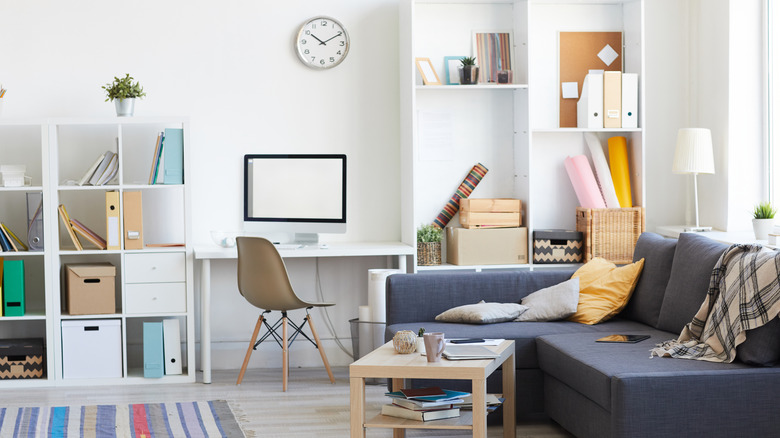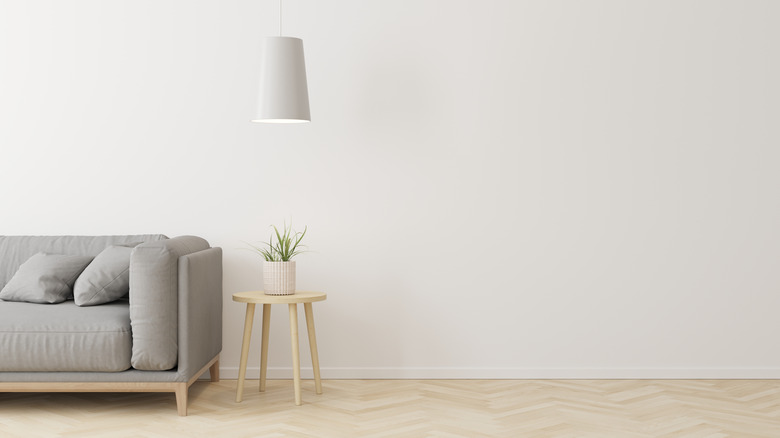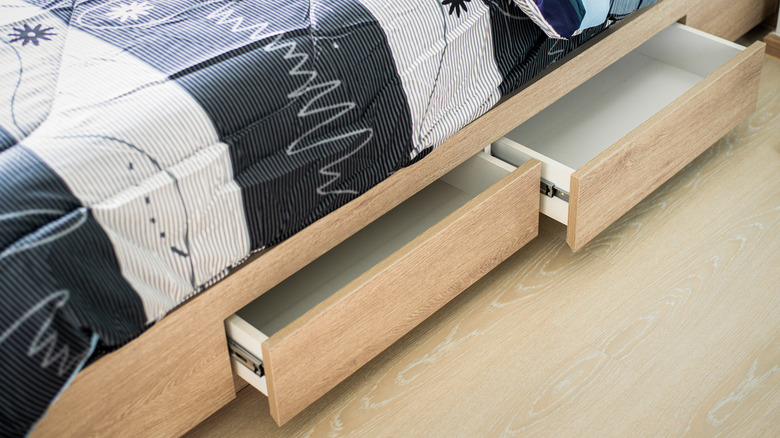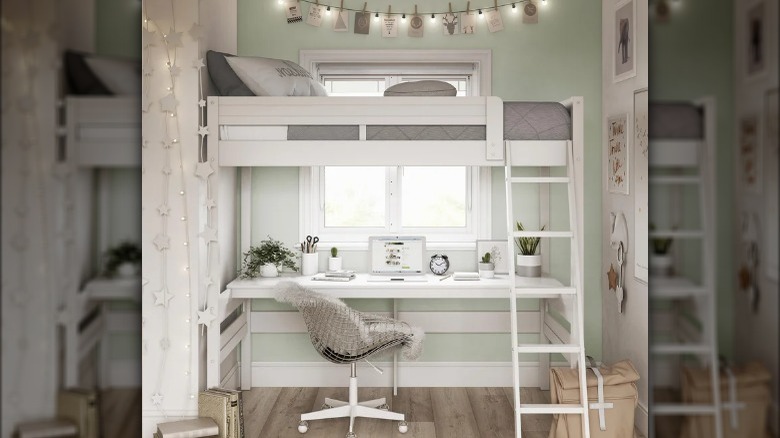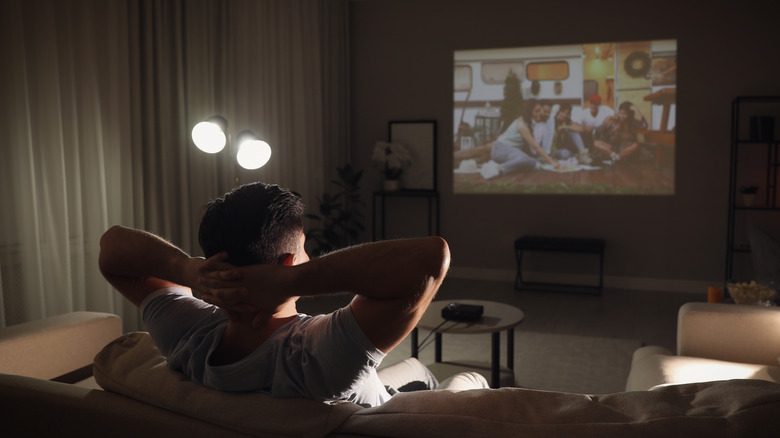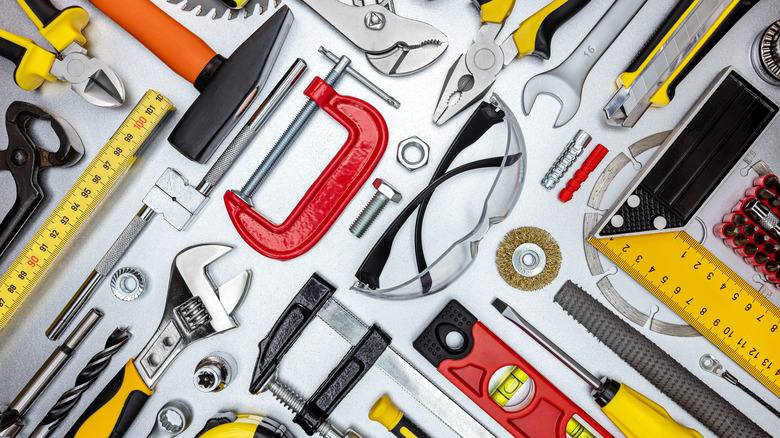5 Tips To Make Living In A Small Studio Apartment Easier
While studio apartments are generally easier on your wallet than larger units, the lack of space (and lack of separate rooms) brings a lot of challenges. If you aren't organized, you may find yourself dealing with a cluttered, cramped living space. It's easy to let things pile up, then feel too overwhelmed to change anything. Fortunately, though, if you are intentional about what you bring into (and remove from) your apartment, you can still enjoy a stylish, functional, and clutterless home.
According to Go Downsize, the average studio apartment is around 500 square feet, though some can be as small as 200 square feet. Either way, with such a small amount of room, it's important that you make strategic decisions when considering the layout, furniture, and decor. To help out, we've rounded up our top tips to make the most of a tiny studio apartment. But a quick word of warning before we dive in: while living in a small space takes a lot of discipline, it can also be tough. Everyone slips up now and again. If you find your space getting way too dirty or cluttered, take a deep breath and focus on improving it piece-by-piece, rather than comparing it to seemingly perfect (and highly curated) studio apartment pictures online.
1. Stick to the basics
With so little space, your shelves (and the rooms themselves) can quickly become cluttered. To keep your space accessible, think about what you really need — how often do you really use that novelty waffle maker? — and eliminate the rest. If you aren't quite ready to part with certain items, consider putting them in storage.
It's easy to take "stick to the basics" as synonymous with "live in a minimalist box" — a comparison that could not be farther from the truth. If you have a minimalist style and genuinely prefer eliminating most clutter, go for it! However, according to the British Psychological Society, items that show off who you are — for example, a musician's beloved record player, an aspiring filmmaker's curated DVD collection, or a scrapbook — are not necessarily correlated with unhappiness in the same way that most materialistic possessions are. In other words, don't shy away from expressing yourself through your apartment's decor, even if the items aren't necessarily "essential."
2. Take advantage of multipurpose furniture
Since studio apartments are infamously small, multipurpose furniture can be a great way to sneak in extra functionality without things getting too crowded. The most common example is probably a pull-out couch, which can be a great way to hide an extra bed in case someone needs to sleep over (or can even double as your own bed), but there are plenty of other space-saving designs out there too. A wall-mounted pull-out desk can be decorated so that it looks like a work of art when in an upright position, while some table and chair sets are specifically made to fit back together like a compact puzzle when not in use.
Unfortunately, most multipurpose furniture tends to be more expensive than its normal counterparts. However, according to Chron, furniture tends to deplete around 20% of its value each year. If you scour Facebook Marketplace, Kijiji, or other similar sites, you can usually find furniture that's in relatively good condition. While it's generally easy to find deals on these sites, you can try haggling down the price even further to stretch your budget.
3. Look into loft beds
Sure, studio apartments typically have small square footage. In fact, according to Pocket Sense, size is one of the biggest differences between a studio apartment versus a trendy loft. But if you're fortunate enough to have a lofty ceiling in your apartment, you'll have a lot of extra vertical space that you can take advantage of.
One of the best ways to take advantage of a studio apartment's extra height? Investing in a loft bed. Generally, these resemble bunk beds, with a regular bed on top and a desk on the bottom (bonus points if you're a remote worker — this is a great hack to fit a home office in a tiny space). However, if you don't need a desk, you can repurpose the bottom area to fit your lifestyle. Feel free to swap it out for an indoor greenhouse, a home bar, an extra couch, or whatever else you can imagine.
4. Consider swapping your TV for a projector
Unless you're planning on watching television in the middle of the day, a projector will generally be a better fit for small spaces such as studio apartments. Not only is a projector's footprint significantly smaller than a television's, but you won't need to restrict your potential furniture layouts even further by designing them around a TV set (which can easily become your studio apartment design's focal point if you're not careful). Plus, if your walls are relatively bare, you can project a huge image onto them — one that's much bigger than most budget-friendly televisions.
That being said, projectors aren't always the perfect fit. According to Popular Science, affordable projectors generally don't come with 4K-level visuals (although, to be fair, you'd also struggle to find an affordable, reasonably-sized 4K television). Plus, you'll have to eliminate any light sources when using the projector — so much for mid-day sitcom breaks or ambient lighting. Ultimately, projectors aren't one-size-fits-all, though they can be a massive space-saver in the right setting.
5. Take advantage of local lending programs
Since studio apartments are relatively small, you should generally second-guess most purchases with a footprint. There's nothing wrong with investing in something that you'll use on a frequent basis, but if you rarely cook, chances are that an air fryer will just sit on the counter collecting dust while taking up valuable space. Thankfully, local lending programs allow you to still experience the joy of experimenting with something new. They're a great resource for anyone, but doubly so when you're low on space.
While traditional libraries are probably the most ubiquitous lending program, they're far from your only option. Tool libraries are becoming increasingly common, allowing you to work on handy projects without carving out space to store supplies later. And specialized libraries are popping up, too (though they're less common). According to Springwise, Toronto is home to a kitchen tool lending library where people can borrow culinary equipment. While you may have to do some research to see what's available in your area, the potential benefits can be huge, especially if you find a library that matches your interests. Plus, borrowing rather than purchasing is eco-friendly and (in most cases) a great way to save money.
